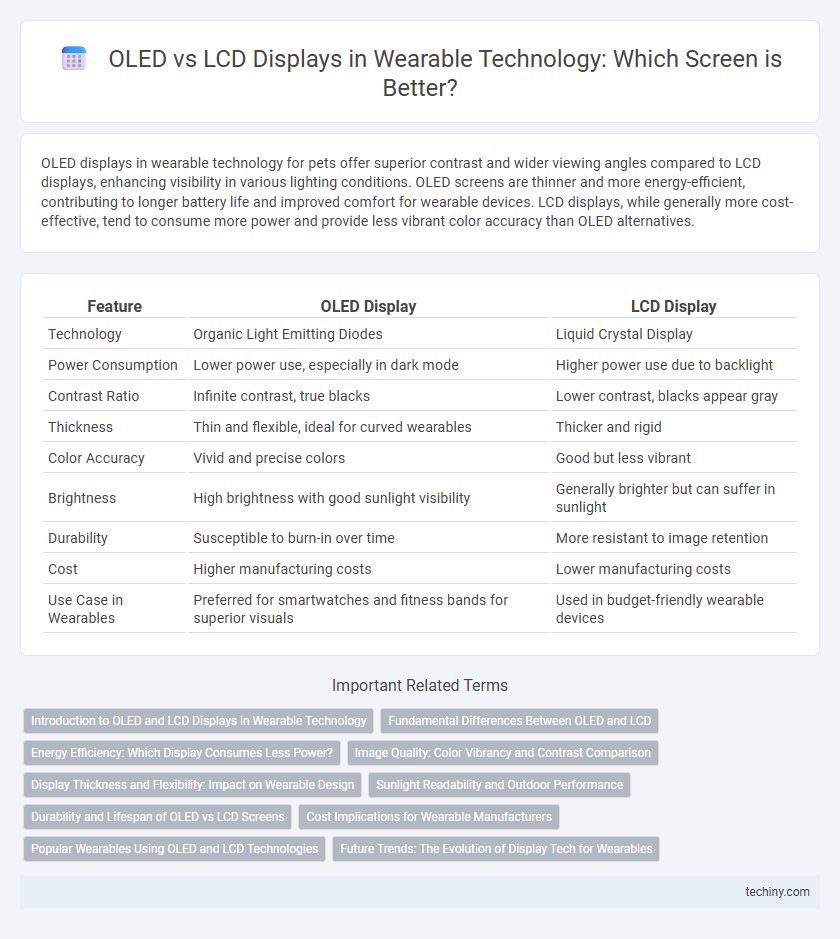OLED displays in wearable technology for pets offer superior contrast and wider viewing angles compared to LCD displays, enhancing visibility in various lighting conditions. OLED screens are thinner and more energy-efficient, contributing to longer battery life and improved comfort for wearable devices. LCD displays, while generally more cost-effective, tend to consume more power and provide less vibrant color accuracy than OLED alternatives.
Table of Comparison
| Feature | OLED Display | LCD Display |
|---|---|---|
| Technology | Organic Light Emitting Diodes | Liquid Crystal Display |
| Power Consumption | Lower power use, especially in dark mode | Higher power use due to backlight |
| Contrast Ratio | Infinite contrast, true blacks | Lower contrast, blacks appear gray |
| Thickness | Thin and flexible, ideal for curved wearables | Thicker and rigid |
| Color Accuracy | Vivid and precise colors | Good but less vibrant |
| Brightness | High brightness with good sunlight visibility | Generally brighter but can suffer in sunlight |
| Durability | Susceptible to burn-in over time | More resistant to image retention |
| Cost | Higher manufacturing costs | Lower manufacturing costs |
| Use Case in Wearables | Preferred for smartwatches and fitness bands for superior visuals | Used in budget-friendly wearable devices |
Introduction to OLED and LCD Displays in Wearable Technology
OLED displays in wearable technology offer superior contrast ratios, flexible design capabilities, and lower power consumption compared to traditional LCD displays. LCD displays rely on backlighting and liquid crystals, which often result in bulkier devices and reduced battery efficiency. Advancements in OLED technology have driven significant improvements in display clarity and user experience for smartwatches and fitness trackers.
Fundamental Differences Between OLED and LCD
OLED displays emit light through organic compounds when an electric current passes through, providing true blacks and higher contrast ratios compared to LCDs, which rely on backlighting to illuminate pixels. LCD displays use a liquid crystal layer between polarized panels, controlling light passage but often resulting in lower contrast and color accuracy. OLED technology offers faster response times and wider viewing angles, making it more suitable for wearable devices demanding vivid visuals and energy efficiency.
Energy Efficiency: Which Display Consumes Less Power?
OLED displays consume less power than LCDs in wearable technology due to their ability to light individual pixels selectively, eliminating the need for a backlight. This pixel-level illumination enables OLEDs to achieve higher energy efficiency, especially when displaying darker images or interfaces. LCDs require continuous backlighting, resulting in higher power consumption regardless of the content displayed.
Image Quality: Color Vibrancy and Contrast Comparison
OLED displays in wearable technology offer superior image quality with richer color vibrancy and deeper contrast levels due to their ability to individually light pixels, resulting in true blacks and more vivid visuals. In contrast, LCD displays rely on a backlight, which often leads to lower contrast ratios and less saturated colors, diminishing the overall viewing experience. This superior color and contrast performance make OLED the preferred choice for wearables demanding vibrant and dynamic visual output.
Display Thickness and Flexibility: Impact on Wearable Design
OLED displays boast significantly thinner profiles and superior flexibility compared to LCD displays, enabling sleek, lightweight wearable devices with enhanced user comfort. The inherent flexibility of OLED technology supports curved and bendable designs, which LCD panels cannot achieve due to their rigid backlighting and liquid crystal layers. This flexibility directly influences ergonomic and aesthetic aspects of wearables, allowing for innovative form factors and improved durability in dynamic usage scenarios.
Sunlight Readability and Outdoor Performance
OLED displays offer superior sunlight readability in wearable technology due to their self-emissive pixels, which deliver higher contrast and deeper blacks compared to LCD displays. LCD screens often struggle with glare and washed-out colors under direct sunlight because of their reliance on backlighting. Therefore, OLED displays enhance outdoor performance with better visibility and energy efficiency in bright environments.
Durability and Lifespan of OLED vs LCD Screens
OLED displays offer superior durability in wearable technology by utilizing organic compounds that are less prone to breakage compared to the rigid glass layers in LCD screens. The lifespan of OLED screens typically ranges between 20,000 to 30,000 hours, significantly influenced by blue OLED material degradation, whereas LCDs can last longer, often exceeding 50,000 hours due to their stable backlighting and liquid crystal structure. However, OLED's flexibility and resistance to impact make it a preferred choice for rugged wearable devices despite its relatively shorter lifespan.
Cost Implications for Wearable Manufacturers
OLED displays generally incur higher production costs than LCDs due to their advanced materials and complex manufacturing processes, impacting the overall budget for wearable technology developers. LCD displays offer cost-effective solutions with simpler manufacturing, making them attractive for budget-conscious wearable manufacturers aiming to optimize price-to-performance ratios. Balancing cost implications with functional and aesthetic advantages remains crucial when selecting display technology for wearables.
Popular Wearables Using OLED and LCD Technologies
Popular wearables utilizing OLED display technology include the Apple Watch Series, Samsung Galaxy Watch, and Fitbit Luxe, offering vibrant colors, deeper blacks, and energy efficiency. In contrast, devices like the Garmin Forerunner and budget fitness trackers often employ LCD displays, which provide better visibility in direct sunlight and cost-effectiveness. OLED displays dominate premium wearables due to their flexibility and superior contrast, while LCDs remain common in entry-level models targeting affordability and durability.
Future Trends: The Evolution of Display Tech for Wearables
OLED displays in wearable technology offer superior contrast, flexibility, and energy efficiency compared to traditional LCDs, driving their increased adoption in future devices. Advances in microLED and foldable OLED technologies promise even thinner, brighter, and more durable screens, enabling innovative wearable designs. Integration of smart display functionalities with AI and AR is expected to redefine user experience, making OLED the dominant display technology in next-generation wearables.
OLED Display vs LCD Display Infographic

 techiny.com
techiny.com